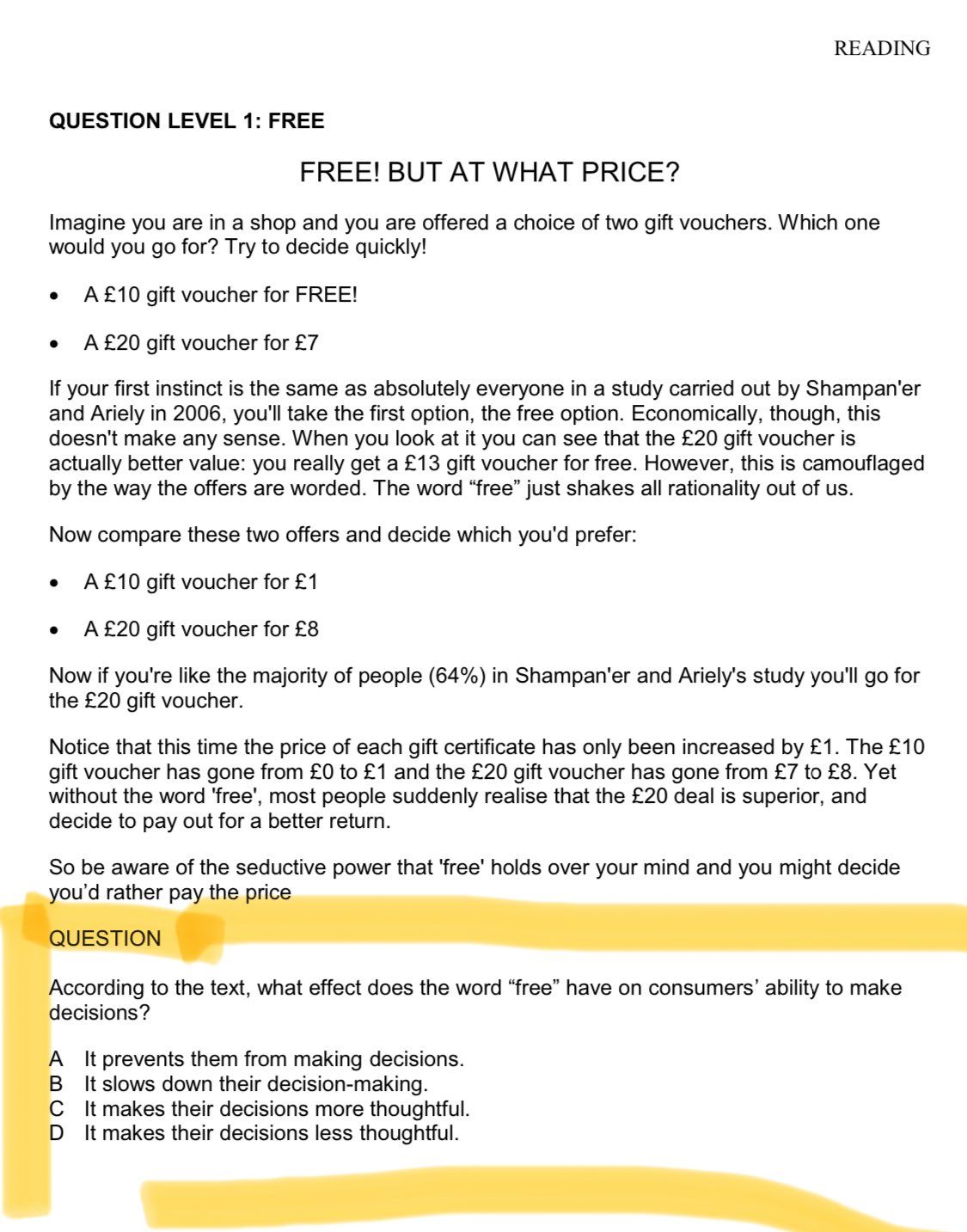Free is easy, cheap is hard
Here is a level one question from the PISA test aimed at 15 year olds:

“According to the text”, the answer is D. The word “free” makes you less thoughtful. But is it such a bad thing to be less thoughtful?
If someone wants to hand you a free voucher, you can’t lose money for holding it in your hands. (Unless you’re someone easily bullied by fast-talking strangers, but then they could do that with anything.) Do you like the store or not? Does the voucher expire? Do you have time to read the terms? Did you just pop in to use the bathroom and have about five seconds before you piss all over this social sciences grad student? Free means not needing to care about all this. It makes you less thoughtful in the sense that catching a baseball is less thoughtful then doing trigonometry to figure out where the ball ought to go. You’re thinking less because you’re busy accomplishing the goal.
To the credit of Shapman’er and Ariely, in the original study, they mostly get there:
One reason for this could be that that the decision to take a chocolate for free is a much simpler decision, and that simplicity could be the driver of higher affect (Tversky and Shafir 1992, Luce 1998, Iyengar and Lepper 2000, Benartzi and Thaler 2002, Schwarz 2002, Diederich 2003, Gourville and Soman 2005). In particular, a free Hershey’s involves benefits and no costs, while a Lindt for any positive price involves both benefits and costs — it is possible that options that have only benefits create more positive affect compared with options that involve both benefits and cots [sic].
But “positive affect” is just another head on that horrid hydra “utility”. Why does a zero cost option have to create more of an abstract measure to be a legible choice? The fact that you can shortcut away from numbers is exactly what’s so nice about free. If you need to encode that shortcut as a number, then of course that encoding is going to seem counter-intuitive. “You don’t like thinking about a precise number of dollars? Interesting. Precisely how many dollars is that worth to you? In numbers, please.”
This is why I really dislike the frame of the word free “shaking all rationality” out of you. Rationality here stands for an endless hunger for arbitrage, an utter devotion to the fungibilty of dollars. 20-for-7 forces you to orient yourself towards the market in a way 10-for-free doesn’t. If you have infinite trust in the market and always accept this orientation, this is fine. But that’s a real easy way to get scammed! If you get a DM from two twitter bots, one offering “$100 of free bitcoin” and another offering “$1000 worth of bitcoin for only $100”, then surely most of us would take the first one if we took any at all. There’s obviously a lot more risk involved in forking over money to get something than the risk in passively accepting. (And even that is not risk zero! If they are a cop they do not actually need to tell you.) This distinction is very salient in bounced check fake job scams: someone will ask “I got this remote job that seems too good to be true, but I’m not paying anything, so I don’t understand how it can be a scam?” Then they learn the dirty trick: the scammer is going to give you an overgenerous check, ask you to pay them back the difference, and then the check will bounce in a couple of days and you’ll be on the hook.
Wow, that’s devious! If only there was a way to be safe to those sort of attacks! Wait, there is; just hold on to your $7 instead of giving it away to the researcher on the promise of making $3 more than you otherwise would just taking the free thing. Damn, that was easy. For only $3, you too can avoid needing to figure out the motives of a behavioral economist. It’s another case of missing the latent structure because the assumption “Everyone in this experiment trusts me and is treating my offerings for trivial amounts of value according to an internal pricing structure they consistently use for all pricing decisions” is one of those untrue things everyone agrees to pretend is true enough that they can keep doing the studies.
What is the real pricing structure people actually use? Well, when stuff gets weird, maybe it’s not a structure at all. Maybe they aren’t represneting this as an internal currency that just has some bonus affect value around zero. Maybe it’s more of a slow, contextual muddle that can handle the increased uncertainty.